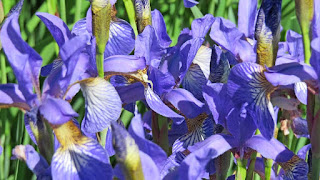This morning I took photos of iris flowers in my yard. I also used my USB microscope to get some close ups.
Iris is a genus of 260–300 species of flowering plants with showy flowers. It takes its name from the Greek word for a rainbow, referring to the wide variety of flower colors found among the many species. Nearly all species are found in temperate Northern hemisphere zones, particularly from Eurasia to Asia. Although diverse in ecology, Iris is predominantly found in dry, semi-desert, or colder rocky mountainous areas, other habitats include grassy slopes, meadowlands and riverbanks.
Irises are perennial plants, growing from creeping rhizomes (rhizomatous irises) or, in drier climates, from bulbs (bulbous irises). They have long, erect flowering stems
which may be simple or branched, solid or hollow, and flattened or have
a circular cross-section. The rhizomatous species usually have 3–10
basal sword-shaped leaves growing in dense clumps. The bulbous species
have cylindrical, basal leaves.
The flower clusters are in the shape of a fan and contain one or more symmetrical six-lobed flowers. These grow on a pedicel or peduncle. The three sepals,
which are spreading or droop downwards, are referred to as "falls".
The flowers are often adorned with
veining, lines or dots. The styles divide towards the apex into petaloid branches; this is significant in pollination. The iris flower is an example of the relation between
flowering plants and pollinating insects. The shape of the flower and
the position of the pollen-receiving and stigmatic surfaces on the outer
petals form a landing-stage for a flying insect.
Cite: https://en.wikipedia.org/wiki/Iris_%28plant%29
Tuesday, June 16, 2015
Subscribe to:
Post Comments (Atom)









No comments:
Post a Comment